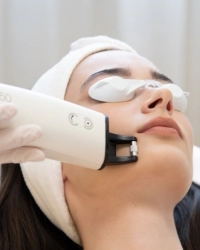Treatment of Phimosis
Gentle and effective solution for phimosis – enhanced comfort and quality of life.
Next

Treatment of Phimosis
The foreskin is the hood-like part of the skin that covers the tip of the penis and, in a healthy state, can be easily retracted from the glans. However, sometimes the foreskin opening is so narrow that it cannot, or can only partially, be pulled back—this condition is known as phimosis. Fortunately, there are various therapeutic methods available for treating phimosis, which vary based on the severity of the condition and any possible complications.
It can also be problematic in adulthood
In many cases, phimosis is not only an issue in childhood but can also cause problems in adulthood. Therefore, treatment is often sought later in life, as a tight foreskin can cause discomfort in daily activities, including hygiene challenges and sexual relations; in rare cases, it may even affect fertility. Phimosis also increases the risk of infections since bacteria can easily accumulate under the tight foreskin, leading to inflammation and other health problems. Left untreated, phimosis can lead to more serious health complications, such as an increased risk of penile cancer or infertility. If you experience phimosis, it is essential to seek medical attention promptly!
What is phimosis?
Phimosis is a condition where the foreskin of the penis is narrow or stiff and cannot, or can only partially, retract over the glans. This condition can occur at various ages and can range in severity.
There are two main types of phimosis:
- Physiological phimosis: This usually occurs in infants and young children and often resolves naturally as the child grows.
- Pathological phimosis: This form often results from inflammation, injury, infection, or scarring and requires medical intervention.
Phimosis should not be ignored, especially if it causes pain, infections, or other discomforts in daily life.
Symptoms indicating phimosis
The primary symptom of phimosis is an inability to retract the foreskin over the head of the penis. Other symptoms may include:
- Swelling and discoloration: The skin around the foreskin may be red or swollen if inflammation or infection is present.
- Pain: Pain may occur during urination, sexual activity, or erection.
- Difficulty urinating: A tight foreskin may impede the flow of urine, causing it to stream weakly or in multiple directions.
- Infections: The area beneath the foreskin can be difficult to clean, promoting bacterial growth.
Who should consider the treatment?
Treatment for phimosis is recommended for any man who has difficulty retracting the foreskin. Medical intervention is particularly important in cases of:
- Persistent pain: If retracting the foreskin causes pain and interferes with normal sexual life or hygiene.
- Signs of infection: If the skin around the foreskin becomes inflamed, shows signs of infection, or has frequent inflammation.
- Urinary problems: If phimosis disrupts the normal flow of urine or if urine remains trapped under the foreskin.
Treatment options
The treatment of phimosis includes various methods depending on the severity of the condition. Treatment can be conservative, such as the application of creams and hygiene practices, but in severe cases, surgical intervention may be necessary.
Corticosteroid creams
In cases of mild phimosis, doctors often recommend the use of corticosteroid creams. These creams help to soften the foreskin tissue, making it easier to retract. Along with the application of creams, doctors may also suggest gentle stretching of the foreskin to improve skin elasticity.
Hygiene practices
Thorough hygiene is essential in managing phimosis, especially if foreskin retraction is difficult. The area under the foreskin should be cleaned regularly and gently to prevent bacterial growth and inflammation.
Surgical procedures
If conservative treatments are ineffective or the phimosis is more severe, surgical intervention may be required. The most common surgical procedures include:
- Circumcision: This involves removing part or all of the foreskin to eliminate the constriction. This is the most commonly used procedure for severe phimosis.
- Preputioplasty: This procedure aims to preserve the foreskin while removing constricted parts, allowing the foreskin to continue protecting the glans but making it easier to retract.
- Frenulotomy: Recommended if the frenulum is too short or tight, which can also make it difficult to retract the foreskin.
Complications associated with untreated phimosis
Without treatment, phimosis can lead to several complications, such as:
- Balanitis or posthitis: These infections often develop when the area under the foreskin cannot be cleaned properly.
- Urinary tract infections: A tight foreskin can block the normal flow of urine, leading to urinary tract infections.
- Paraphimosis: This condition occurs if the foreskin gets stuck behind the glans after retraction and cannot be pulled forward again. It can cause severe swelling and pain and requires urgent medical intervention.
- Poor hygiene: Phimosis makes it difficult to clean under the foreskin, promoting bacterial growth.
How long does recovery take after surgery?
The recovery period varies depending on the type of surgery and the patient's condition. After circumcision, most patients can resume normal activities within a week, whereas recovery after preputioplasty may take longer. Maintaining proper hygiene and following the doctor’s instructions are essential for a smooth recovery.
What are the prospects after treatment?
With proper treatment, phimosis can be entirely resolved and usually does not recur. Both conservative treatments and surgical procedures yield good results, especially if the condition is identified early. Maintaining good hygiene and undergoing regular medical check-ups can help prevent a recurrence of phimosis.
Phimosis treatment offers various therapeutic options, with the choice of method depending on the severity of the condition. Conservative approaches, such as corticosteroid creams and hygiene practices, may help in milder cases, while surgical interventions provide a lasting solution for more severe cases. If you notice symptoms of phimosis, do not delay a medical consultation, as early intervention can prevent more severe complications!
Prices
| Plastic surgery consultation with examination - Dr. Máté Jancsó | 30 000 Ft |
Appointment
Service
Selecting a location

Selecting a specialist

The main sign of phimosis is an inability to retract the foreskin over the head of the penis. Other symptoms include swelling, pain during erection, difficulty urinating, and frequent infections due to hygiene issues.
In mild cases, phimosis can be managed with corticosteroid creams and hygiene practices, but severe phimosis often requires surgical intervention.
The level of discomfort depends on the type of treatment. Conservative treatments cause minimal discomfort, while surgical procedures, like circumcision, are performed under local anesthesia to minimize pain.
Recovery time depends on the type of surgery but typically takes one to two weeks. It’s essential to follow the aftercare instructions from your doctor for a swift recovery!
Untreated phimosis can lead to severe complications, including infections, painful urination, and an increased risk of penile cancer or infertility.













